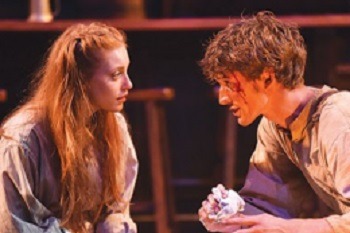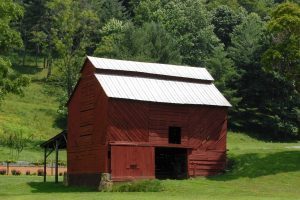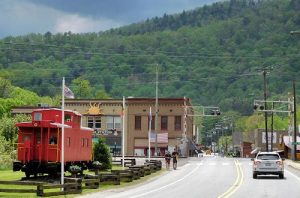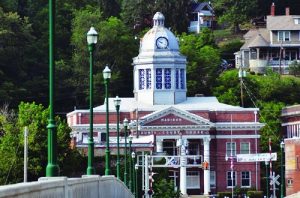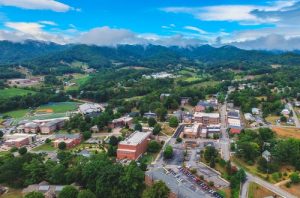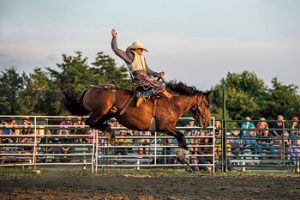This distinction comes not only from bringing the style of dancing to the area in colonial times but also from Bascom Lamar Lunsford’s place in helping develop team clogging during the late 1920s at the annual Mountain Dance and Folk Festival. One of the favorite performances at the annual Heritage Festival in Mars Hill is the Bailey Mountain Cloggers of Mars Hill University.
HISTORY OF CLOGGING
Clogging—also referred to as flat-footing, buck dancing, jigging, foot-stomping and clog dancing—is a blend of dances brought by early settlers to this area. Although most people think that it takes its origins from square dancing, this is not where or how clogging began. Some references date clog dancing (its official name) back as far as the 1400s. The word “Clog” comes from the Gaelic, and means “time.” Brought to the colonies by the settlers, this dance style took jigs from the Irish and the Scots; clogging from the English; buck dancing from the black Africans and created Appalachian style clogging. Some clogging steps include a stomp thought to come from the native Cherokee. It is truly an example of the melting pot aspect of the new world—a “melting pot” of step dances. They all share a common component and that is that the dance style is accentuated by the type of shoes that are worn during the dance. The shoes are used to make a loud percussion sound with the toe or heel. In some cases both the toe and heel combine to make a rhythm.
Here in Madison County, old timers and young people alike often take that dance style passed down from generation to generation for granted and simply call it dancing. In fact, at many of the traditional music concerts such as Bluff Music Festival in June or many of the concerts sponsored by the Arts Council, members of the audience will come forward to dance on the floor cleared for just that purpose. They may not wear shoes with taps that make the loud sounds of the professional cloggers, but their style and enthusiasm are still the same.
TEAM CLOGGING
At the turn of the 20th century, many flat-foot and buck dancers began to add this developing step dance to the big circle dances that had been enjoyed in their communities for decades. One of clog dancing’s most renowned founders, Bascom Lamar Lunsford, a native son of Madison County, helped to popularize the art of team dancing by adding it as a category of competition in the annual Mountain Dance and Folk Festival held in Asheville in 1928. In those early years, the dance teams used a gliding step while dancing that today is referred to as “smooth” dancing.
That year at the Festival a group called the Soco Gap Dance Team won the competition with a routine featuring precision mountain figures accompanied by freestyle step dancing. This team was formed by Sam Love Queen, Sr. of Maggie Valley, NC. His grandson Joe Sam Queen is a frequent visitor to Madison County as he served 3 terms as NC State Senator from District 47.Joe Sam is one of those that we see joining in the dancing at local concerts as he comes by the talent naturally.
The Soco Gap Dancers became well known for their energetic style and in 1939 they were selected by Lunsford to perform for the King and Queen of England at the White House. It is reported that her majesty remarked to First Lady, Eleanor Roosevelt, that the footwork was very much like “Clogging” in her country. The term stuck, and the media used the term in documenting the performance. The step dance which emerged from the Southern Appalachian Mountains became known as “clog dancing”.
Modern competitive clogging, also called precision clogging is inspired by those traditional styles but you will also see the teams performing to a wide variety of music, including bluegrass, modern country, rock music, pop, and hip hop. Additionally, the traditional style has evolved from flat foot to dancing on the balls of the feet. Clogging has come a long way since the first settlers brought their various dance styles with them. Millions watched a North Carolina clogging group kick and click at the 1996 Olympics in Atlanta. The Irish group Riverdance, with its modern version of the jig that inspired American clogging, earned a Grammy and a spot in the 1997 Academy Awards program. In 2003, clog dancing was included as a competitive dance sport in the AAU Junior Olympics.
A prominent and highly respected representative of the dance and music traditions, Rodney Sutton lives in Madison County. He is a native of Eastern North Carolina, where his family has danced and played music for generations. Sutton is particularly known for his expertise in traditional mountain dance. He is adept at both flatfooting and clogging.
Rodney Sutton
Kelsey Sutton
Clay Sutton
And, he believes and lives the commitment to keeping the tradition alive by teaching the dance to children and adults alike. His two children, Kelsey and Clay, were members of the Cole Mountain Cloggers who have been state youth champions since 2006. These young dancers, ranging in age from 5 through 17 years old, are proud to represent their mountain heritage while upholding their motto of “Keeping a Mountain Tradition Thriving.” Three members of the team are related to Bascom Lamar Lunsford who helped popularize team clogging in 1928. They can be seen every year performing at the Heritage Festival in Mars Hill in October as well as for many benefits throughout Western North Carolina.
BAILEY MOUNTAIN CLOGGERS
Bailey Mountain Cloggers
Madison County is proud to boast of the Mars Hill College based Bailey Mountain Cloggers who have been National Champions in clogging competition every year since 1990. Their history began with an older championship team in the town of Mars Hill called Bailey Mountain “Square” Dance Team. (Their name derives from Bailey Mountain which is adjacent to the Mars Hill College campus.) The Square Dance Team was made up of young adults from both the town and the college.In the spring of 1950, they toured with Bascom Lamar Lunsford. Lunsford was key to the development of team clogging when he promoted dance team competition at the first Mountain Dance and Folk Festival held in Asheville in 1928. By the end of the 1960s, precision clogging was included in the Mountain Dance and Folk Festival in Asheville. Before that time, only Mountain “Square” Dance, and freestyle clog dancing were part of the folk festival. Influenced by the Square Dance Team, the Bailey Mountain Cloggers were organized in1974 by students at Mars Hill College in the town of Mars Hill. During the 1980’s the Bailey Mountain Cloggers began competition clogging and expanded their clog repertoire to include more than precision clog routines. They are one of a few college-based performing clog teams in the nation. Madison County residents are lucky to be able to watch a free performance every year at the Heritage Festival in October as well as attend many of their performances throughout the school year.
Madison County’s place in traditional music history is not limited just to the singing and the fiddle and banjo-playing (to name just a few of the instruments), we also have claim to a place in the history of clogging. This distinction comes not only from bringing the style of dancing to the area in colonial times but also from Bascom Lamar Lunsford’s place in helping develop team clogging during the late 1920s at the annual Mountain Dance and Folk Festival.
Clogging—also referred to as flat-footing, buck dancing, jigging, foot-stomping and clog dancing—is a blend of dances brought by early settlers to this area. Although most people think that it takes its origins from square dancing, this is not where or how clogging began. Some references date clog dancing (its official name) back as far as the 1400s.The word “Clog” comes from the Gaelic, and means “time.”Brought to the colonies by the settlers, this dance style took jigs from the Irish and the Scots; clogging from the English; buck dancing from the black Africans and created Appalachian style clogging. Some clogging steps include a stomp thought to come from the native Cherokee. It is truly an example of the melting pot aspect of the new world—a “melting pot” of step dances. They all share a common component and that is that the dance style is accentuated by the type of shoes that are worn during the dance. The shoes are used to make a loud percussion sound with the toe or heel. In some cases both the toe and heel combine to make a rhythm.
Here in Madison County, old timers and young people alike often take that dance style passed down from generation to generation for granted and simply call it dancing. In fact, at many of the traditional music concerts such as Bluff in June or many of the concerts sponsored by the Arts Council, members of the audience will come forward to dance on the floor cleared for just that purpose. They may not wear shoes with taps that make the loud sounds of the professional cloggers, but their style and enthusiasm are still the same.
Team clogging:
At the turn of the 20thcentury, many flat-foot and buck dancers began to add this developing step dance to the big circle dances that had been enjoyed in their communities for decades. One of clog dancing’s most renowned founders, Bascom Lamar Lunsford (LINK to his page), a native son of Madison County, helped to popularize the art of team dancing by adding it as a category of competition in the annual Mountain Dance and Folk Festival held in Asheville in 1928. In those early years, the dance teams used a gliding step while dancing that today is referred to as “smooth” dancing. That year at the Festival a group called the Soco Gap Dance Team won the competition with a routine featuring precision mountain figures accompanied by freestyle step dancing. This team was formed by Sam Love Queen, Sr. of Maggie Valley, NC. His grandson Joe Sam Queen is a frequent visitor to Madison County as he served 3 terms as NC State Senator from District 47.Joe Sam is one of those that we see joining in the dancing at local concerts as he comes by the talent naturally.
The Soco Gap Dancers became well known for their energetic style and in 1939 they were selected by Lunsford to perform for the King and Queen of England at the White House. It is reported that her majesty remarked to First Lady, Eleanor Roosevelt, that the footwork was very much like “Clogging” in her country. The term stuck, and the media used the term in documenting the performance. The step dance which emerged from the Southern Appalachian Mountains became known as “clog dancing”.
Modern competitive clogging, also called precision clogging is inspired by those traditional styles but you will also see the teams performing to a wide variety of music, including bluegrass, modern country, rock music, pop, and hip hop. Additionally, the traditional style has evolved from flat foot to dancing on the balls of the feet. Clogging has come a long way since the first settlers brought their various dance styles with them. Millions watched a North Carolina clogging group kick and click at the 1996 Olympics in Atlanta. The Irish group Riverdance, with its modern version of the jig that inspired American clogging, earned a Grammy and a spot in the 1997 Academy Awards program. In 2003, clog dancing was included as a competitive dance sport in the AAU Junior Olympics.
A prominent and highly respected representative of the dance and music traditions, Rodney Sutton lives in Madison County. He is a native of eastern North Carolina, where his family has danced and played music for generations. Sutton is particularly known for his expertise in traditional mountain dance. He is adept at both flatfooting and clogging. And, he believes and lives the commitment to keeping the tradition alive by teaching the dance to children and adults alike. His two children, Kelsey and Clay, are members of the Cole Mountain Cloggers who have been state youth champions since 2006. These young dancers, ranging in age from 5 through 17 years old, are proud to represent their mountain heritage while upholding their motto of “Keeping a Mountain Tradition Thriving.” Three members of the team are related to Bascom Lamar Lunsford who helped popularize team clogging in 1928. They can be seen every year performing at the Heritage Festival in Mars Hill in October as well as for many benefits throughout western North Carolina.
BAILEY MOUNTAIN CLOGGERS
Madison County is proud to boast of the Mars Hill College based Bailey Mountain Cloggers who have been National Champions in clogging competition every year since 1992. Their history began with an older championship team in the town of Mars Hill called Bailey Mountain “Square” Dance Team. (Their name derives from Bailey Mountain which is adjacent to the Mars Hill College campus.) The Square Dance Team was made up of young adults from both the town and the college.In the spring of 1950, they toured with Bascom Lamar Lunsford. Lunsford was key to the development of team clogging when he promoted dance team competition at the first Mountain Dance and Folk Festival held in Asheville in 1928). By the end of the 1960s, precision clogging was included in the Mountain Dance and Folk Festival in Asheville. Before that time, only Mountain “Square” Dance, and freestyle clog dancing were part of the folk festival.
Influenced by the Square Dance Team, the Bailey Mountain Cloggers were organized in1974 by students at Mars Hill College in the town of Mars Hill. During the 1980’s the Bailey Mountain Cloggers began competition clogging and expanded their clog repertoire to include more than precision clog routines. They are one of a few college-based performing clog teams in the nation. Madison County residents are lucky to be able to watch a free performance every year at the Heritage Festival in October as well as attend many of their performances throughout the school year.


